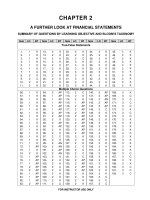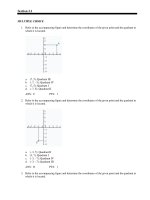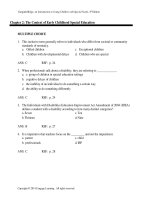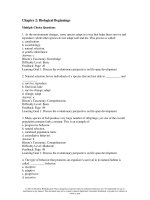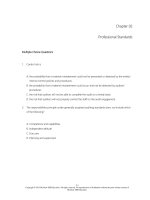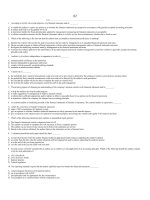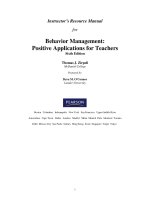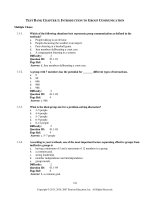Customer service career success through customer loyalty 6th edition timm test bank
Bạn đang xem bản rút gọn của tài liệu. Xem và tải ngay bản đầy đủ của tài liệu tại đây (14.29 KB, 3 trang )
ESSAY. Write your answer in the space provided or on a separate sheet of paper.
1) Explain the distinction between attitudes and behaviors. Why is it important to focus on behaviors rather than
attitudes when seeking to improve customer service?
2) What is a company's "culture?" What are some key characteristics of the culture at Yum! Brands, Southwest
Airlines, and Zappos?
3) Describe four ways we can greet customers like guests.
4) Describe three examples of "verbal disciplining" your self-talk.
5) What are some aspects of a company's appearance and grooming that should be monitored for
appropriateness?
MULTIPLE CHOICE. Choose the one alternative that best completes the statement or answers the question.
6) A behavior that can impact customer service includes:
A) living by a positive mission statement.
B) poor work attitudes.
C) greeting customers promptly.
D) giving great service.
6)
7) Vital behaviors are:
A) the same as good attitudes.
B) activities that are required by law.
C) not particularly important when influencing employees.
D) specific actions that have the greatest impact on good service.
7)
8) Which of the following can be an effective "icebreaker" when greeting a customer?
A) talking about something of local interest like the weather
B) expressing appreciation for them coming in
C) responding to some interest of the customer such as a sport or activity, based on cues
D) All of the above.
8)
9) Regarding acts that get customers to interact with the company:
A) it doesn't matter so much what they do so long as they begin to do something.
B) can help them sample the company culture.
C) can take the form of inviting them to begin filling out paperwork.
D) All of the above.
9)
10) The "L" in the acronym LIFE stands for:
A) little things.
C) liabilities associated with poor service.
10)
B) labeling key vital behaviors.
D) limited services.
11) When a customer is not acknowledged or greeted promptly:
A) the organization misses an opportunity to establish a positive relationship.
B) he or she is likely to estimate that the time waiting to be served is longer than it may
objectively be.
C) the customer may leave the organization and go elsewhere.
D) All of the above.
1
11)
TRUE/FALSE. Write 'T' if the statement is true and 'F' if the statement is false.
12) The appearance of a store, shop, or office conveys nonverbal messages to customers.
12)
13) Rewarding employees for doing some behaviors may be counterproductive if not consistent with
good service.
13)
14) Corresponding with customers using old media such as mailed notes or thank you cards will
reflect badly on a company's service–it will seem old-fashioned.
14)
15) When a customer is focusing on a particular product (a focused shopper) should be left alone so
that they can decide for themselves and not feel pressured.
15)
16) Generally people appreciate being called by name although not always by their first name.
16)
17) Saying "no problem" when a customer thanks you is generally better than the more formal "you're
welcome."
17)
18) Some employees need to actually practice smiling like an actor might.
18)
2
Answer Key
Testname: UNTITLED19
1) Behaviors are distinguished from attitudes by the fact that they are explicit actions that can be observed, measured,
and learned. While behaviors may reflect a person's attitudes, only behaviors are visible.
2) Culture is an organization's personality as revealed by behaviors. Yum! Brands emphasizes a "recognition" culture by
giving fun awards to employees. Southwest stresses "having fun" and Zappos adheres to its "10 Commandments"
which include "creating fun and a little weirdness" and "delivering 'wow'."
3) Initiate conversation promptly, speak up, greet customers with your eyes, get customers committed.
4) Replacing any judgmental phrase such as "what an ugly dress" with more neutral descriptions such as "she dresses
interestingly." Examples should reflect non-judgment.
5) Any unsightly, messy, untidy, or poorly maintained facilities can be good examples. Common ones: unattractive store
or office, poor merchandise display, cluttered work areas, dirty restrooms.
6) C
7) D
8) D
9) D
10) A
11) D
12) TRUE
13) TRUE
14) FALSE
15) FALSE
16) TRUE
17) FALSE
18) TRUE
3
